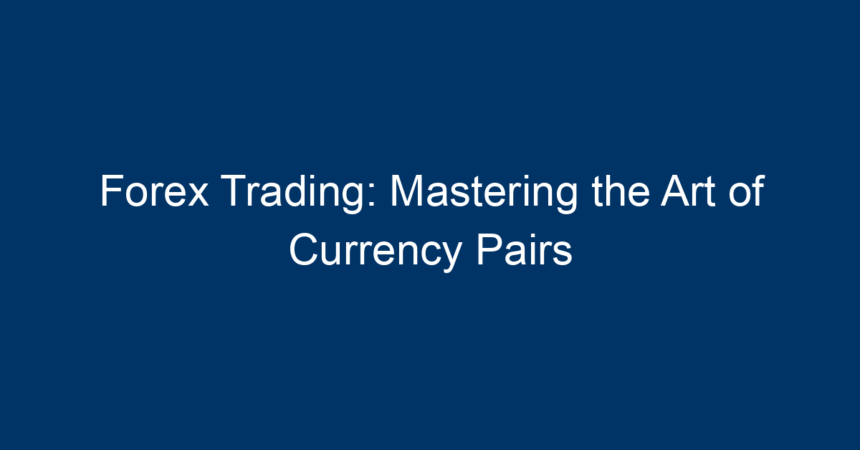Introduction
In the dynamic world of finance, forex trading stands out due to its sheer volume and complexity. With a global daily trading volume exceeding $6 trillion, the foreign exchange market (or forex market) is the largest financial market in the world. Whether you’re a seasoned trader or a curious beginner, understanding the nuances of currency pairs is crucial for success. In this article, we’ll delve into the intricacies of forex trading, focusing particularly on mastering currency pairs. By the end, you’ll be equipped with actionable strategies that can enhance your trading journey.
What Are Currency Pairs?
In forex trading, currencies are traded in pairs, reflecting their relative values. A currency pair consists of two currencies: the base currency, which is the first in the pair, and the quote currency, which is the second. For instance, in the pair EUR/USD, the Euro is the base currency and the US Dollar is the quote currency. Here’s a breakdown of the components:
- Base Currency: This is the currency you are buying or selling.
- Quote Currency: This represents the value of the base currency in terms of the quote currency.
Understanding currency pairs is fundamental to forex trading. They are categorized into three main types:
- Major Pairs: These involve the most traded currencies, such as EUR/USD, USD/JPY, and GBP/USD.
- Minor Pairs: These pairs do not involve the US Dollar but include currencies such as EUR/GBP and AUD/NZD.
- Exotic Pairs: These consist of a major currency paired with a currency from a developing economy, such as USD/TRY (Turkish Lira).
The Importance of Understanding Currency Pairs
Mastering currency pairs is essential for several reasons:
- Volatility and Liquidity: Major pairs tend to be more liquid and less volatile, making them safer bets for beginners. Understanding the volatility of different pairs can lead to informed trading decisions.
- Interest Rates and Economic Indicators: Currency pairs react sensitively to interest rates and economic announcements. Traders must stay abreast of these factors to anticipate price movements effectively.
- Correlation and Diversification: Understanding how different currency pairs correlate can help in risk management. Diversifying your trades across correlated and non-correlated pairs can mitigate risk.
How to Read Currency Pairs
Reading currency pairs involves understanding the price quoted. For example, if you see EUR/USD at 1.2000, it means 1 Euro is equivalent to 1.2 US Dollars. Here’s how to interpret changes:
- Appreciation: If the pair moves from 1.2000 to 1.2050, the Euro has appreciated against the Dollar.
- Depreciation: Conversely, if the pair drops from 1.2000 to 1.1950, the Euro has depreciated.
Being able to read these fluctuations allows traders to make educated decisions, setting the stage for successful forex trading.
Analyzing Currency Pair Trends
Fundamental Analysis
Fundamental analysis examines economic indicators, interest rates, and geopolitical events that affect currency values. Key indicators include:
- GDP Growth: A growing economy usually strengthens its currency.
- Inflation Rates: High inflation can diminish purchasing power, leading to currency depreciation.
- Employment Reports: Strong employment figures are a sign of economic health.
Keeping an eye on these indicators can help traders predict possible movements in currency pairs.
Technical Analysis
Technical analysis relies on charts and statistical data to predict future movements. Here are popular technical indicators used in forex trading:
- Moving Averages: These smooth out price data to identify trends.
- Relative Strength Index (RSI): This measures the speed of price changes and identifies overbought or oversold conditions.
- Fibonacci Retracement Levels: Traders use these levels to identify potential reversal points.
Combining both fundamental and technical analysis can yield more comprehensive insights into currency pairs, increasing a trader’s probability of success.
The Psychology of Forex Trading
Psychology plays a critical role in forex trading. Emotions can greatly impact decision-making, leading to impulsive trades. Here are some psychological factors to consider:
- Fear and Greed: Fear can cause traders to exit profitable trades prematurely, while greed may lead to holding onto losing trades. A balanced mindset is crucial.
- Discipline: Sticking to a well-laid strategy is important for long-term success. Emotion-driven decisions can result in costly losses.
- Patience: The best opportunities arise not from rushing into trades but from taking a measured approach.
Building a strong psychological foundation can be just as crucial as mastering the technicalities of currency pairs.
Actionable Insights for Mastering Currency Pairs
-
Start with Major Pairs: If you’re new to forex trading, begin with major pairs to familiarize yourself with market movements.
-
Develop a Trading Plan: A well-defined trading plan outlines your goals, risk tolerance, and entry/exit strategies.
-
Use Demo Accounts: Before diving into real trading, practice with a demo account to test your strategies without risking capital. This allows you to gain confidence.
-
Stay Educated: Continual learning is key in the ever-evolving market. Webinars, online courses, and forex trading forums are excellent resources.
-
Manage Risk Carefully: Use stop-loss orders and position sizing to limit potential losses. Never risk more than a small percentage of your capital on a single trade.
- Evaluate Your Performance: Regularly analyze your trades to identify what works and what doesn’t. Keeping a trading journal can aid this process.
Conclusion
Mastering the art of currency pairs is fundamental to becoming a successful forex trader. By understanding the mechanics of forex trading, analyzing trends, and managing emotions, you can significantly enhance your trading performance. Remember, success in forex trading requires patience, discipline, and continuous learning. With the right strategies and mindset, you can navigate the complexities of the forex market with confidence. Start your trading journey today, and may your trades be favorable!




